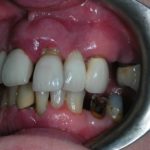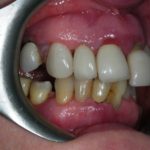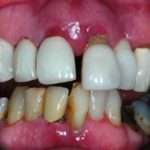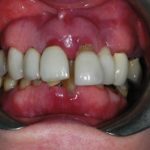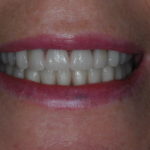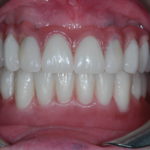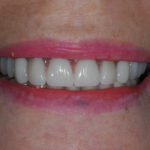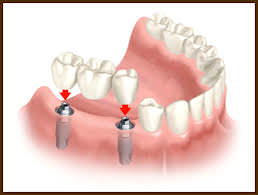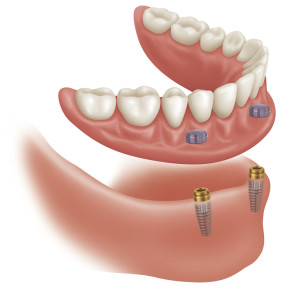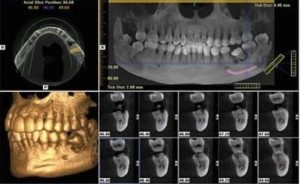Dental implants have revolutionised how we replace missing teeth since they were first developed almost 30 years ago. At StoneRocks Dental Implant Clinic, an implant can be used to replace anything from a single tooth to an entire set of teeth and can be used to support crowns, bridges or dentures and their impact are often life changing for people.
At StoneRocks Dental Implant Clinic in Hawkhurst, Nr Cranbrook, Kent we are proud to have several Dental Surgeons with vast experience in implants Antonio De Vivo is a dental surgeon who has placed over 2000 implants and holds Diplomas in both Implantology and Restorative Dentistry. Russell and Ian have both restored many hundreds of implants for over 10 years and both have completed extensive post graduate training in this field.
In its simplest form an implant retained crown consists of three components- the implant (a titanium screw that is embedded in the jaw bone), the abutment ( a central threaded “post” that attaches to the implant) and the crown ( a porcelain fused to metal crown that is either screwed or cemented in place, depending on requirements). (See diagrams below).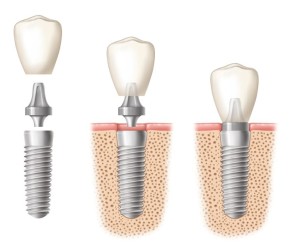
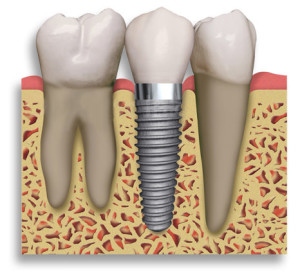
The implant is placed via a minor surgical procedure that can take place at the time of the extraction (an immediate placement) or a few months later (a delayed placement). Once the surrounding bone has fused to the implant (a process known as “osseointegration”) then we can restore the implant with the abutment and the definitive crown. Sometimes it is possible to place a temporary crown at the time of surgery when placing the implant which then provides a good aesthetic solution during the integration phase, although this is usually preferred when there are multiple implants that can be linked together rather than just a single implant on its own.
An implant retained crown is seen as an excellent alternative to a dental bridge which often requires significant removal of sound tooth tissue from the intended support teeth either side of the gap.
Implant crowns provide excellent long term predictability and give a finished result that can look and feel and function like a natural tooth. No procedure in medicine or dentistry comes with a 100% guarantee of success, however, and there are risks and complications associated with all implant work that must always be considered before choosing this treatment option.
If there are a number of missing teeth then we can use multiple implants to support an implant bridge, which can be extended to fill an entire jaw if needed.
The process for an implant retained bridge is very similar to that for an implant retained crown although clearly the surgery becomes more complicated the more implants that are placed at any one time. As with all implant based treatments there is a healing period for osseointegration which will take 3-6 months depending on how much bone there is at the time of surgery and how well supported the implants are at this initial stage. Where we have multiple implants, however, it is often possible for us to fit a temporary bridge on the day of surgery meaning that patients can come in with their existing, failing teeth in the morning and leave with their new implant (temporary) bridge in the afternoon. A definitive bridge is then fitted approximately 3-6 months later when the implants are fully integrated.
Full arch fixed implant retained bridges are often used to replace existing full dentures that a patient has not been able to get on with or have become too loose to function properly. Patient’s regularly report just how much this transition can change their lives.
One particular type of full arch implant bridge is known as the “All on 4” technique and can further details on this approach can be found by following the link to our separate page on this.
Implant retained dentures
Some patients don’t mind wearing a full denture but just wish that they were better retained and didn’t move when they were eating. For these patients the use of implants to retain the denture can give them what they want at a lower cost than fixed implant bridge work. Typically we use 2-4 implants in the lower jaw and 4 in the upper for a full denture and the implants can either be linked together by a metal bar that the denture clips on to or they can be left as individual studs that the denture attaches to. Often we can use the existing denture or we can make a new one depending on the condition of the current set. As with other implant procedures there is a surgical stage to fit them and they are usually left buried during healing and then exposed to attach to the denture when fully integrated.
Planning an implant case: how we do it at StoneRock Dental Care
If a patient comes to our implant clinic interested in an implant solution then we will carry out a full examination of the entire mouth to assess not just the teeth and gums adjacent to the proposed site but of all the dental structures as we need to know the overall health of the mouth before considering any implant work. As implant solutions are just one of several ways of replacing a failing or missing tooth we will provide information on all options, along with a written report and an estimate of cost for each approach, if appropriate. (For more information on dentures, conventional and adhesive bridges please see are section on “Mind the Gap”).
It is normal for two dentists to work together on many such cases with Dr Ian Kerr or Dr Russell Blanchard planning the overall treatment but working with Dr Antonio de Vivo for the surgical component regarding the implant placement.
If it is agreed that an implant solution is the most appropriate one then we will take impressions (moulds) of teeth to create study models that will help us plan the ideal implant position more accurately. If there is a large gap to fill then we will often make a “radiographic stent” which is a plastic mould made from the study model that replicates where we want the teeth to go in the final restoration. This stent shows up on any radiographs and allows us to plan exactly where to place the implants.
It is very common for us to take cone beam CT scan of the proposed site as this gives us a 3D image of the jaw bone and tell us how much bone there is, what density it is and whether there are any important anatomical structures near where we wish to place the implant.
If the scan shows up any potential problems regarding the case then we will discuss these with the patient well in advance of any planned procedure and will offer solutions or alternative treatment options as appropriate.
It is often necessary to enhance the surgical site to provide better bone or tissue volume around the implant and this is usually done with products such as PRGF which is gel/graft material derived from a blood sample taken from the patient prior to surgery and/or a bone replacement material known as BioOss which is derived from specially reared cows. (None animal based BioCeramic materials are also available for patients who do not wish to use animal products). If there is very little bone present then it may be necessary to graft the area first and then wait 6 months before placing the implants. In these circumstances we would usually bury the implants and leave them a further 6 months before restoring them to give the very best chance of long term success.
Likely costs involved in an implant procedure
- Initial Consultation (for patients new to the practice) £98
- Study models and cone beam CT scan £295
- Surgical placement of single implant £1150
- PRGF/ BioOss £240
- Exposure of implants (if buried at the time of surgery) £95
- Restoration of a single implant retained crown £1150
- Temporary denture/ adhesive bridge (if needed on aesthetic grounds) £395
For more detailed prices of other implant procedures please see our Implant Price list.
Problems with Implants
There is no surgical procedure in all of medicine and dentistry that comes with a 100% guarantee of success and clearly this applies to dental implants as well. With this in mind we like to inform all of our potential clients how best to avoid dental problems generally and what extra work implants require. In addition to this we make known the more common complications and unwanted outcomes that we face when providing implant work.
General Prevention advice
Sugary foods can cause decay and it would be sensible for you to reduce the intake of sugars to a minimum, so as to minimise the changes of further decay in your mouth.
Proper hygiene is critical to the future success of the implants and must be maintained. Like natural teeth, implants may be affected by lack of hygiene and can actually be lost due to its neglect. Adherence to maintenance schedules is imperative. The gums around implants are susceptible to a condition known as Peri-implantitis which is similar in progression to gum disease that can occur around natural teeth. Peri-implantitis will often develop a few years after an implant has been placed and, like gum disease, is hard to spot in the early stages but can be prevented through excellent oral hygiene. In severe cases however it can lead to the premature loss of the implant.
If you are a smoker we would urge you to stop as it has a significant effect on the success rate of dental implants, if you continue, all complications will be fully chargeable
Failures
Fortunately failures in implant dentistry are rare but for every 100 that we place we expect to see problems in 2-4 cases in the first 12 months.
In some instances implants fail to integrate in the first few months after placement. A problem with healing is usually apparent early after the implants are placed and patients with problems with healing usually report problems with mild swelling, discomfort and bad taste from the site. In our experience we see this happen in approximately 2% of case. If there are no obvious risk factors present (we will have discussed these with you if there are) then we will replace the original implant at no further cost to you. In the majority of cases that we replace an implant for the second one heals uneventfully but for a small percentage of cases the second one fails and in these individuals it is likely that they will not have an implant solution in this site.
The titanium implant, abutments and/or screws may loosen, fracture or be damaged in such a way to necessitate the repair, or loss of part of the metal implant system. (In our experience this is very rare.)
Complications following surgery include among other things pain, swelling, limited jaw opening, bleeding, infection, sinus opening, nasal infection swelling and inflammation at the fixture site. In the lower jaw implants may be placed close to the nerve that supplies the lip and tongue. If we are planning work in this region we will require a 3D conebeam CT scan of the area to ensure that we keep a safe distance away from it. With careful planning the risk of inadvertent nerve damage is extremely low but can result in temporary or, extremely rarely permanent altered sensation to the lip and or tongue. In the upper jaw we need to know the position of the floor of the maxillary sinus so again will require a 3D conebeam CT scan to know if we are able to avoid the floor altogether or, as a planned procedure, lift the floor out of the way.
Some failures are hard to account for and probably reflect the body’s inability to heal adequately around the implant. This can present early on with a failure to integrate or can occur after the first year as the attachment between the implant and the bone rapidly breaks down. Your general health can impact on your ability to heal and significant changes in your health (diabetes, coronary disease etc) can impact on the health of the tissues around an implant.
Longevity
It is very rare for any restoration placed on either an implant or a natural tooth to be thought of as a “restoration for life”. For this reason we always need to plan ways to minimise the impact of the dentistry we are doing and plan for future dental needs, albeit perhaps in 10 -15 years time.
Based on all the current research available in dentistry it is not possible to say with any accuracy how long implants last for. Our best guess is that will do very well for the first 10- 15years but beyond this we cannot say for sure how things will last. In some patients, for the reasons mentioned above, the implants may not last as long as this.
Please see the following pages for more information. Implant FAQs
If you would like more information or to make an appointment at our Dental Practice in Hawkhurst, Nr Cranbrook on the Kent and East Sussex border please contact our Reception Team on 01580 752202 or info@stonerock.co.uk who will be more than happy to help with any matter.
